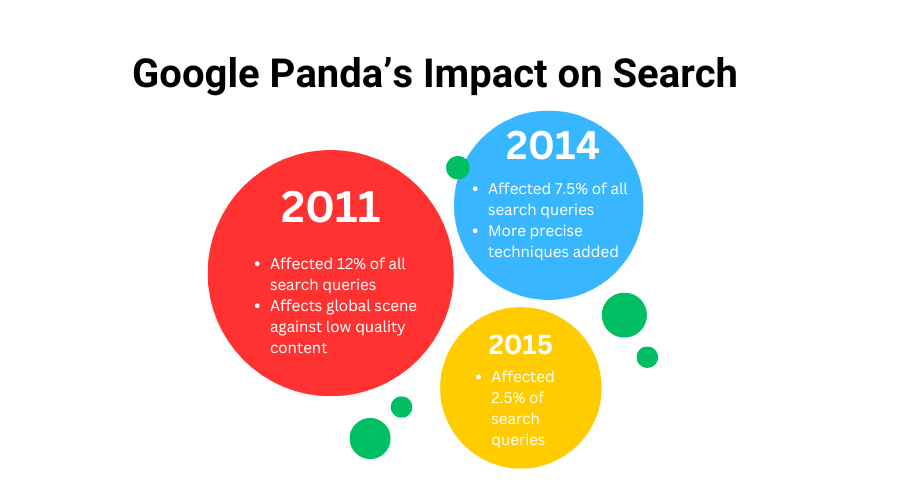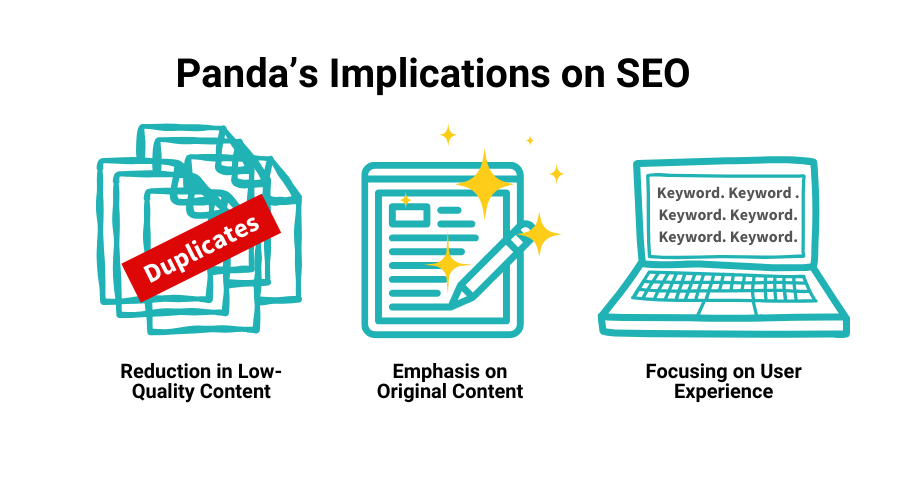Updated July 22, 2024
Reading Time: 5 minutes
Making SEO History
In February 2011, Google unveiled an algorithm update they dubbed “Panda.” It was the first of many algorithm releases to target low-quality websites, keeping them off the search results page (SERP). Before the Google Panda release, spammy websites with duplicate content or keyword-stuff pages were gaming search rankings. Panda combated those content generators by removing them from SERPs and enhancing the quality of search results with relevant information useful to searchers. Essentially, Panda rewarded original content that was written for a human audience. This shift significantly altered the SEO landscape, cracking down on Black and Grey Hat SEOs.
The impact was immediate and substantial. Panda affected approximately 12% of all search queries. The update’s focus was clear: penalize sites with minimal or duplicated content while rewarding those with substantive, unique material. Not only did the update enhance the quality of search results, it also established a new benchmark for web content. Eventually, Panda was integrated into Google’s core algorithm.
Panda’s Updates
Over the years, Google’s Panda continued to refine the way Google assessed and ranked web content. Most notable are those shown below, showing how it impacted the SEO landscape:

- Panda 1.0 (February 2011)
The first iteration of the Panda algorithm had a significant impact, affecting about 12% of all search queries. This update targeted content farms and sites with thin or low-quality content, pushing them off the SERP and replacing with high-quality, original content.
- Panda 2.0 to 3.0 (April 2011 – October 2011)
Subsequent updates expanded Panda’s reach globally and integrated additional signals (such as user feedback) to further refine search results. Panda updates continued to penalize low-quality content while rewarding sites that offered valuable, engaging information.
- Softer Panda Update (July 2013)
Adjusted the algorithm to accommodate small businesses and sites that contained quality content previously penalized.
- Gentler Panda Algorithm (May 2014)
This update further refined quality signals, ensuring high-quality, user-friendly sites were not penalized. Google adjusted the algorithm to provide a fairer assessment of site quality, improving the algorithm’s ability to differentiate between low-quality content and sites of value.
- Panda 4.0 (May 2014)
Panda 4.0 marked a significant overhaul of the algorithm, impacting roughly 7.5% of search queries. This update further improved how the algorithm detected and demoted sites with thin or duplicate content. A higher percentage of websites experienced Panda’s wrath.
- Panda 4.1 (September 2014)
More precise techniques to identify low-quality content were introduced in this update, benefiting small and medium-sized websites containing high-quality pages and posts. Approximately 3-5% of search queries were affected, further promoting the importance of substantive, user-friendly content.
- Panda 4.2 (July 2015)
Panda 4.2 affected around 2-3% of search queries. The gradual nature of this release gave web admins additional time to refine their content strategies and make changes to better align with Panda’s quality guidelines. The focus remained on penalizing thin content and improving the visibility of sites with original, high-quality content.
Its Lasting Impact on SEO

Google’s Panda algorithm updates forever changed how SEOs prioritized content quality and user experience. Its impact continues to today’s content strategy and optimization tactics.
- Reduction in Low-Quality Content: Panda effectively reduced the SERP visibility of low-quality websites and content farms, promoting a higher content standard across the web. The algorithm targeted websites that produced thin or duplicated content created only to boost clicks rather than engagement. By demoting these low-quality sites, Panda forced many content farms to either improve their content quality or face a decline in traffic and revenue. We can thank Panda for a cleaner, more reliable organic search experience.
- Emphasis on Original Content: Sites with unique, human-centric content saw improved rankings, thus encouraging web admins to focus on originality and depth. Google’s preference for high-quality content shifted from shallow, keyword-stuffed articles to more comprehensive, well-researched and value-add pieces. This trend urged creators to produce material that meets users’ needs, providing detailed and informative content. Panda helped ensure that users encountered fewer redundant or low-value pages in their search results.
- A Focus on User Experience: Websites that previously relied on keyword stuffing or minimal content on a page found it necessary to adopt more user-centric approaches. As a result, websites began prioritizing user engagement metrics such as time on site, bounce rate, and user interaction. Higher engagement levels often correlate with higher-quality content that meets user expectations and needs. Panda also influenced websites to improve their content presentation — overall design, navigation, intuitive usability — to elevate user experience.
Community and Expert Opinions
The introduction and evolution of the Google Panda algorithm elicited various reactions from the SEO community and industry experts. Various industry polls, such as those conducted by Search Engine Land and Moz, reveal mixed reactions to the Panda updates. While some webmasters reported significant drops in traffic and rankings, others experienced positive outcomes due to their focus on high-quality content.
Surveys indicated that many websites had to revamp their content strategies to recover from Panda penalties. The approach focused on removing low-quality content, revamping existing content, and prioritizing user engagement metrics.
Experts like Danny Sullivan from Search Engine Land and Rand Fishkin (when at Moz) emphasized that Panda set a new quality standard. They reported that original, valuable, and engaging content performed better in search rankings.
In general, industry leaders acknowledged that Panda updates initially posed challenges, they ultimately benefited users and serious content creators. The quality shift encouraged a healthier web ecosystem where content is created with the user in mind rather than solely for search engine manipulation.
SEO Best Practices Post-Panda
The landscape of SEO has shifted dramatically since the Panda update. Today, crafting high-quality content that resonates with users is paramount. Here’s how to excel in this new era:
- Content is King (and Queen): Focus on creating original, engaging content that caters to your target audience’s needs. Leverage data and analytics to understand user search intent and tailor your content accordingly.
- User Experience Reigns Supreme: Fast loading times and a mobile-friendly design are no longer optional – they’re essential. Prioritize clear headings, intuitive navigation, and well-structured content to make navigating your site a breeze.
- Sustainable SEO: Forget manipulative link-building schemes; focus on earning natural backlinks through genuinely valuable content. Regularly audit and update your content to maintain its relevance and freshness.
By adopting a holistic approach that balances on-page optimization, high-quality content creation, and ethical link-building practices, you’ll build resilience against future algorithm changes. This aligns perfectly with the principles championed by the Panda update, setting you on the path to long-term SEO success.

 Unlocking Creativity: How Jetpack AI Assistant Transforms Content Creation
Unlocking Creativity: How Jetpack AI Assistant Transforms Content Creation